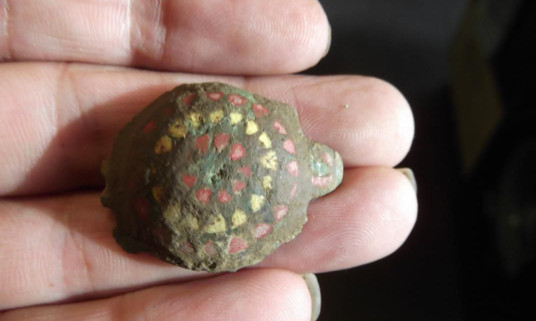When he first pulled it from a muddy field, Bonnybridge man Shug McCreadie was struck by the vivid colours on the small lump of metal.
Careful inspection of the piece revealed it to be a brooch from the Roman era and the bright yellow and red enamel shone as brightly as the day it was first painted.
Now experts have confirmed that the jewellery, which was unearthed near Blairgowrie, is of a type rarely found in Scotland.
Specialists say the piece, known as an umbonate brooch, is “reasonably common” in England but finding one north of the border is “significant”.
The brooch was uncovered near an area known to have been inhabited for a time by Romans, though the exact location is a closely guarded secret.
Metal detectorist Shug and his friends had been on the point of packing up and going home when his equipment alerted him to the treasure just below his feet.
The 51-year-old church officer said he has never found anything like it in the three years he has been metal detecting.
He said: “They are very rare up in Scotland because the Romans were only here for a few years. It wasn’t far away from one of the forts it’s definitely Roman.
“I was excited because it’s not very often you pull up anything Roman in Scotland but to pull something like that up, that’s been on somebody, is really good. I did a wee dance once I realised what it was.
“I gave it a quick wipe with my finger to make sure it was a brooch. I saw the colours immediately it was bright, vivid colours in the earth and, because it was wet, they were a lot brighter than they are now.
“I was quite surprised it still had that amount of colour, especially in Scotland. I’ve found a few things in England that still have enamel on them but never anything in Scotland.
“I’ve found some Roman things here before but never a nice brooch, complete with enamel.”
The find was not the only one Shug made that day, with both now handed over to government experts.
He said: “I found two things that day, the other is a possible Roman hairpin.
The treasure trove department has both of them. They are excited about the brooch because it still has enamel on it and it’s quite rare to find an umbonate brooch. They are nicknamed ‘the turtle brooch’ because of its shape.”
He added that the piece was now likely to end up on display locally.
He said: “It’s going to be claimed. Treasure Trove will put it out to museums and it will probably be Perth Museum that takes it.
“I always like to see things on display it’s nice to know you’ve contributed to Scotland’s heritage. This is part of the history of Scotland and that’s why most people metal detect they want to find something that’s historically important.”
A spokesman for Treasure Trove Scotland said the brooch could possibly indicate Romans trading with locals.
He went on: “Any Roman find from Scotland is significant but a brooch like this is quite an unusual type to find in Scotland.
“There are a number of Roman sites in the adjacent area, so there are obvious questions to ask for example, whether the brooch is connected to one of those sites, or whether it represents Roman interaction with the native population.
“Regarding the bright colours, it’s not rare to find an object in that condition. The colouring is vitreous enamel, which is highly durable. so even an object of this age can be in good condition.”
